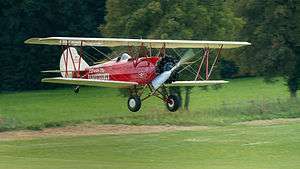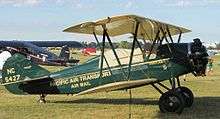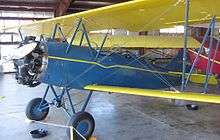Travel Air 2000
| 2000, 3000, 4000, CW-14, Sportsman, Osprey | |
|---|---|
 | |
| Travel Air 4000, at landing | |
| Role | biplane aircraft |
| Manufacturer | Travel Air, Curtiss-Wright |
| Designer | Lloyd Stearman |
| First flight | 13 March 1925[1] |
| Introduction | 1925 |
| Primary user | private owners, aerial sightseeing businesses |
| Produced | 1925–1930 |
| Number built | approx 1,300[1] |
|
| |
The Travel Air 2000/3000/4000 (originally, the Model A, Model B and Model BH)[1] and later marketed as a Curtiss-Wright product under the names CW-14, Speedwing, Sportsman and Osprey), were aircraft produced in the United States in the late 1920s by the Travel Air Manufacturing Company. Travel Air produced more aircraft during the period from 1924-1929 than any other manufacturer.[2]
Design and development
The types shared a common structure of a conventional single-bay biplane with staggered wings braced by N-struts. The fuselage was of fabric-covered steel tube and included two open cockpits in tandem, the forward of which could carry two passengers side-by-side.
Like other aircraft in the Travel Air line, it was available with a variety of different, interchangeable wings, including a wing shorter and thinner than the rest known as the "Speedwing" designed, as the name suggests, for increased cruise speed. Travel Air entered a specially-modified Model 4000 (designated 4000-T) in the Guggenheim Safe Aircraft Competition of 1930, but it was disqualified.
Steam powered
In 1933 a Travel Air 2000 was modified by George and William Besler where the usual inline or radial gasoline piston engine was replaced by an oil-fired, reversible 90° angle V-twin angle-compound engine of their own design, which became the first fixed-wing airplane to successful fly using a steam engine of any type.[3][4] The Beslers are thought to have sold the plane to the Japanese in 1937.[5]
Curtiss-Wright production
Following Travel Air Manufacturing Company purchase in August 1929[6] by Curtiss-Wright, the Model 4000 continued in production into the early 1930s as the CW-14, and the range was expanded to include a military derivative dubbed the Osprey. This was fitted with bomb racks, a fixed, forward-firing machine gun, and a trainable tail gun. These aircraft were supplied to Bolivia and used during the Gran Chaco War, which eventually led to Curtiss-Wright's successful prosecution for supplying these aircraft in violation of a U.S. arms embargo.
Variants
- Model B
- Travel Air Model A fitted with a Wright J-6 piston engine.
Like other Travel Air aircraft, Model 4000 variants were distinguished by letters prefixed (or occasionally affixed) to the basic designation to denote different engine and wing fits. These letter codes included:



- A
- original wing with "elephant-ear" ailerons
- A
- Axelson engine
- B
- "standard wing" with Frise-type ailerons and three fuel tanks
- C
- Curtiss engine
- D
- "speedwing"
- E
- revised "standard wing" with a single fuel tank
- K
- Kinner engine
- L
- Lycoming engine
- Travel Air 2000
- first production model
- SC-2000
- powered by a 160-hp (119-kW) Curtiss C-6 engine
- Travel Air 3000
- powered by a 150-hp / 180-hp (112-kW / 134-kW) Hispano-Suiza Model A or Model engine.
- A-4000
- powered by a 150-hp (112-kW) Axelson engine
- B-4000
- powered by a 220-hp (164-kW) Wright J-5 engine
- BC-4000
- floatplane version
- B9-4000
- powered by a 300-hp (224-kW) Wright J-6-9 engine
- C-4000
- powered by a 170-hp (127-kW) Challenger engine
- E-4000
- powered by a 165-hp (123-kW) Wright J-6-5 engine
- K-4000
- powered by a 100-hp (75-kW) Kinner K5 engine
- SBC-4000
- floatplane version
- W-4000
- powered by 110-hp (82-kW) Warner Scarab engine
Curtiss-Wright models built
- CW-14C Sportsman
- Version with 185 hp (138 kW) Curtiss Challenger engine (1 built).[7]
- CW-A14D Deluxe Sportsman
- Three-seat version with 240 hp (180 kW) Wright J-6-7 engine and NACA cowling (5 built).[7]
- CW-B14B Speedwing Deluxe
- Version with 300 hp (220 kW) Wright J-6-9 engine (2 built).[7]
- CW-B14R Special Speedwing Deluxe
- Single-seat racer built for Casey Lambert with supercharged Wright R-975 engine (1 built)
- CW-C14B Osprey
- militarized version with Wright R-975E engine
- CW-C14R Osprey
- militarized version with Wright J-6-9 engine
- CW-17R Pursuit Osprey
- CW-B14B with uprated engine; possibly not built
Operators
Military operators
 Bolivia
Bolivia- 20 purchased 1933–34.[8]
 Colombia
Colombia- 3 from 1932.[8]
 Ecuador
Ecuador- 2 CW-14Rs purchased 1931.[8]
 Panama
Panama- 2 acquired 1931.[8]
 El Salvador
El Salvador- 3 from 1933.[8]
 Venezuela
Venezuela- 3 CW-14Rs purchased 1932.[8]
Aircraft on display
Museum aircraft include:[9]
- Canada Aviation and Space Museum
- EAA AirVenture Museum
- National Air and Space Museum
- Reynolds-Alberta Museum
- Virginia Aviation Museum
Survivors
An airworthy Travel Air 4000 resides in the collection of Fantasy of Flight in Polk City, Florida. In 1997, this aircraft was used by the U.S. Postal Service to help commemorate the first day issue of a series of airplane stamps. With the local Postmaster on board, owner Kermit Weeks delivered the first ever airmail in the history of Polk City; probably the last as well.[10]
Specifications (CW-A14D)
Data from Specifications of American Airplanes[11]
General characteristics
- Crew: 1
- Capacity: 2 passengers
- Length: 23 ft 7 in (7.19 m)
- Wingspan: 31 ft 0 in (9.45 m)
- Height: 9 ft 10 in (3.00 m)
- Wing area: 248.0 sq ft (23.04 m2)
- Empty weight: 1,772 lb (804 kg)
- Gross weight: 2,870 lb (1,302 kg)
- Fuel capacity: 58 US gal (48 imp gal; 220 L)
- Powerplant: 1 × Wright Whirlwind , 250 hp (190 kW)
Performance
- Maximum speed: 155 mph (249 km/h; 135 kn)
- Cruise speed: 132 mph (115 kn; 212 km/h)
- Stall speed: 56 mph (49 kn; 90 km/h)
- Range: 530 mi (461 nmi; 853 km)
- Service ceiling: 18,000 ft (5,486 m)
- Rate of climb: 1,000 ft/min (5.1 m/s)
See also
- Aerial operations in the Chaco War
- Deland Travel Air 2000, a modern replica of the aircraft
References
- Notes
- 1 2 3 Simpson 2007, p. 553
- ↑ Wings Over The Prairie, Ed Phillips, 1994
- ↑ "World's First Steam Driven Airplane" Popular Science, July 1933, detailed article with drawings
- ↑ George & William Besler (April 29, 2011). The Besler Steam Plane (YouTube). https://www.youtube.com/watch?v=nw6NFmcnW-8: Bomberguy.
- ↑ Where have all the Dobles gone, The Steam Automobile, Vol 7 No 1, Spring 1965, page 23
- ↑ Simpson 2001, p. 553
- 1 2 3 Bowers 1979, p. 404.
- 1 2 3 4 5 6 Hagedorn 1992, p. 72.
- ↑ Ogden 2007, p. 541
- ↑ Clark/Nikdel/Powell (2013-10-17). "1929 Travel Air 4000". Fantasy of Flight. Retrieved 2014-01-21.
- ↑ Aviation March 1936, pp. 82–83.
- Bibliography
- Bowers, Peter M. (1979). Curtiss Aircraft 1907–1947. London: Putnam. ISBN 0-370-10029-8.
- Hagedorn, Dan (March–May 1992). "Curtiss Types in Latin America". Air Enthusiast. No. Forty-five. pp. 61–77. ISSN 0143-5450.
- Ogden, Bob (2007). Aviation Museums and Collections of North America. Air-Britain (Historians) Ltd. ISBN 0-85130-385-4.
- Simpson, Rod (2001). Airlife's World Aircraft. Shrewsbury: Airlife Publishing Ltd. ISBN 1-84037-115-3.
- "Specifications of American Airplanes". Aviation. Vol. 35 no. 3. March 1936. pp. 82–85. (registration required (help)).
- Taylor, Michael J. H. (1989). Jane's Encyclopedia of Aviation. London: Studio Editions. p. 288.
- World Aircraft Information Files. London: Bright Star Publishing. pp. File 891 Sheet 54.
- NASM website
- AirVenture Museum website
- Virginia Aviation Museum website
External links
![]() Media related to Travel Air 2000 at Wikimedia Commons
Media related to Travel Air 2000 at Wikimedia Commons